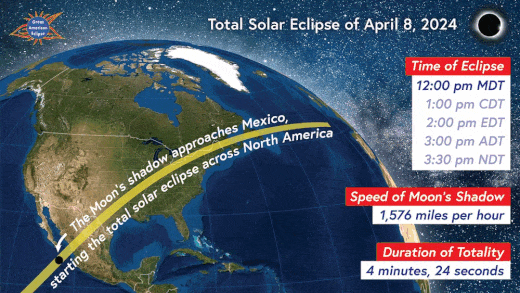"Unexpected" Solar Storm Effect, Eclipse, ENSO | S0
Geo-magnetic pole shift underway and speeding up
Solar eclipse forecast! Best Viewing area. Sunday night Earthquake update. 4/7/2024

Good morning. Monday, April 8th
Eyes Open. No Fear.
What all 50 states will see during the solar eclipse
https://www.kgw.com/article/news/world/solar-eclipse/solar-eclipse-april-8-what-time-it-starts-50-states/507-8ae0368a-91b8-4bd5-99e1-6ad9a163727f
What time is the total solar eclipse on April 8? Search your ZIP code for a viewing guide
https://www.usatoday.com/story/graphics/2024/03/19/what-time-is-solar-eclipse-interactive-map/72747827007/
==
Total solar eclipse of April 8, 2024 – Best chances for clear viewing
The NWS Weather Prediction Center has updated its key messages for the total solar eclipse and cloud cover forecast on April 7. While high clouds spanning across parts of the totality path are likely, they may not completely obscure the eclipse.
https://watchers.news/wp-content/uploads/2024/04/nws-wpc-total-solar-eclipse-cloud-cover-forecast-april-8-2024.webp
The best chances for clear viewing are most likely across northern New England but are also possible from northern Arkansas to central Indiana. The latter, however, is an area of greater uncertainty due to the potential for high clouds.
The clouds will most certainly impede viewing from Texas into southern Arkansas and across Ohio, northwest Pennsylvania, and New York.
==
SOLAR ECLIPSE BALLOON LAUNCH: Dr. Tony Phillips and the staff of Spaceweather.com are in Texas for today's total eclipse. The team will launch an Earth to Sky cosmic ray balloon carrying cameras above the clouds to photograph the Moon's shadow from the stratosphere. Thunderstorms may make the launch very challenging.
THE STRANGE CHILL OF THE MOON'S SHADOW: A 100-mile wide shaft of cool air is about to race through Earth's atmosphere faster than 1500 mph. It's the shadow of the Moon created by Monday's total eclipse of the sun. This animation shows the progress of darkness across the United States:
https://www.spaceweather.com/images2024/01apr24/eclipse_anim_strip_opt.gif
Animation credit: GreatAmericanEclipse.com
Solar eclipses make their own weather--starting with the temperature. How much the temperature falls depends on the humidity. Dry environments could see a drop of 8 to 14 degrees, less so if it’s humid. According to NASA, an eclipse in Zambia on June 21, 2001, reduced the temperature nearly 15 degrees.
The reduction in temperature can make clouds disappear. Satellites observing eclipses from Earth orbit have detected many examples. A 10-year study just published in Nature found that cumulus clouds begin dissipating when a mere 15 percent of the sun is covered. In some cases, clouds didn’t start to return until 50 minutes after maximum eclipse.
This could be good news for eclipse chasers in Mexico and Texas, where widespread cloudcover is expected on April 8th.










